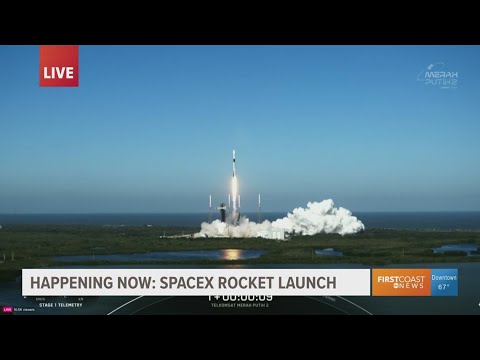SpaceX launches Falcon 9 rocket on anniversary of first American to orbit Earth

for our first hello there we go there's my mic hello everyone thank you for joining us for our first live stream of event with the uh commentary before we show you this rocket launch and we're doing this today especially because it's a big day one we do have a SpaceX Falcon 9 launch that's aiming for 311 p.m. so hopefully within the next 10 11 12 minutes we will get that launch also though it's a big day it's an anniversary it's the 62nd anniversary of the first American successfully orbiting the Earth so what better way to celebrate an anniversary than actually having a launch in our own backyard so what I'm going to do is let's talk about first the first orbit of an American because it also happened in our own backyard on this day in 1962 John Glenn that was his name he was the first American to orbit Earth so what he he launched from the Kenn Space Center down in Cape Canaveral in Project Mercury's friendship 7 spacecraft and he circled the Earth three times before splashing down in the Atlantic and so on this day in 1962 that's when he successfully launched and then splashed back down the flight took 4 hours 55 minutes and 23 seconds so this is a look at the Mercury friendship 7 capsule this was of course the capsule that he used that he launched from the Kennedy Space Center it was an atlas launch vehicle a Mercury spacecraft he landed in the ocean about 800 Mi southeast of the Kennedy Space Center in the vicinity of Grand Turk Island so with this launch this reestablished NASA and the us as a strong contender in the space race with the Soviet Union so as you know the Soviet Union launched the first spacecraft Sputnik that was back in October 1957 the Soviet Union also sent the first human into space in April 1961 so NASA NASA excuse me that's the county NASA sent the first American into space in May of 1961 but it was only a suborbital laot lob so with this that what you're looking at right now that's the Friendship seven that is what they sent John Glenn into space with and he did make three orbits which sometimes a little bit of a confusion three orbits was the plan all along sometimes some people say it was going to be seven orbits but it was three that was a plan it was successful so here's a look at Mercury mission control center from back in the day looks different now now people are prepping down in the cape for the SpaceX launch so let's take a look at this we are heading down to Cape Canaveral all of your friends and family down in that area about to watch the launch the weather couldn't be more perfect for it lots of sunshine out there uh and this launch is going to launch from space space launch complex 40 That's SLC 40 at space uh space force station in Cape Canaveral this is a window from 311 to 511 now if it doesn't work out today there's a backup window tomorrow that's going to be from 12:53 to 453 p.m. so a 4H hour window tomorrow a 2hour window today but hopefully we'll get this launch right at 311 so here along the First Coast if you're about to step outdoors and watch it look how perfect it is you can see there that live stream from Cape canaval same view for our outside beautiful blue skies out there Crystal Clear Skies so we will be able to see the launch it's going to launch to the east so not Northeast which would be a little bit better for our viewing here along the First Coast but not Southeast just directly off to the East and this is a cool launch so you might see here it's launching a satellite that will provide faster internet to Indonesia so it's launching a satellite it's not a starling link space launch but they're going to launch a satellite for Indonesia to bring faster and better internet to them so again this is going to launch at 3:11 and the launch trajectory is off to the east so if you are going to step Outdoors we would like you to please take a picture if you can see it and make sure to post it on our First Coast News weather Watchers Facebook page because we would love to show your photos I'm going to try to put something together for the evening newscast and who knows we might be able to share your photo as well so again this is going to be off at 311 I'm going to load this up for us too again so what I wanted to show you here maybe we could take this full screen because to the left what you're looking at is a spacecraft that's on the pad right now a pad 40 this is the actual Falcon 9 rocket that's about to launch that was tweeted out by SpaceX just a little while ago to your right that is the rocket that launched on this day 62 two years ago that carried John Glenn up and around earth three times so look at the difference between those two rockets that you know a lot has stayed the same but obviously a lot has changed and so that's the difference between the modern technology and some Earth shattering groundbreaking technology back in the day back in 1962 so again what we're here for we are waiting for the launch at 311 from Cape Canaveral and we are also reflecting on history that was made on this day as well so on this day in 1962 John Glenn you can see his photo there he became the first American to orbit Earth he launched from the Kennedy Space Center he landed in the ocean about 800 miles Southeast of the Kennedy Space Center in the vicinity of Grand Turk Island but before he did so he successfully orbited Earth in Project Marcy's friendship seven spacecraft three times and the flight to Circle three times around the entire Globe took 4 hours 55 minutes and 23 seconds that's a look at the capsule my have things have changed but there's a look also that is John Glenn in the photo next to his capsule as well credit to the Smithsonian institution and NASA for these photos and again that's a closer look at the rocket that they use the Friendship 7 spacecraft that they use to launch up into outer space and that's a look at the Mercury Mission Control Center again right now we are waiting to hear from control center down uh and hear word from Cape Canaveral from SpaceX for their 311 launch so every once in a while we've been showing you a live look from there too maybe we could get that as well in the boxes because looks good for launch the weather looks nice as well and we can see beautiful blue skies when we've been checking in on our live cameras and our live feed that SpaceX is showing us for their live launch there it is look how gorgeous it is again beautiful blue skies great conditions great conditions for us to view it here along the First Coast too so temperatures comfortable if you want to step out the door we're sitting in the 60s all across the First Coast now we have those same beautiful blue skies and this will be launching from 311 to 511 that's the window hopefully right at 3:11 but the window will last until 5:11 p.m. and then if it doesn't launch today there's going to be a 4H hour window tomorrow where it could go up to and it's a cool launch because it's actually launching a satellite into space that will bring better faster internet to Indonesia so good stuff going up into our atmosphere and nice satellites up there launch trajectory to the east so while we like Northeast trajectories here because it gives us the best view of those Rockets and the longest view of those Rockets to the east not too bad we'll still be able to see it especially with these clear skies usually when it launches to the southeast we can still see it fairly well just not for as long as a period of time and again it's not to the southeast today it's directly to the east so generally speaking this is what I think it will look like this is going to launch out to the east the red arrows on your screen that's the Rockets trajectory now I'm going to pull this up here I had some notes so what you see when it comes to the white arrows here this is going to be of the the boosters it's going to be the 17th launch of the first stage boosters so once it separates it's going to land on the Drone ship called just read the instructions it's stationed out in the Atlantic Ocean so the white arrows those are the Space X boosters and once it separates it will head to just read the instructions drone ship and then out to the east will the satellite continue as it goes out into orbit I have an amazing crew upstairs are you guys keeping an eye on the time how much longer do we have until 3 minutes and 20 seconds 19 18 seconds now so look at that the weather perfect especially great to see after the Rainy weekend we had so good to see the sun come out tomorrow so this is a live stream from SpaceX that we're taking and you can see the countdown right here too and at some point we will pull this up full screen on your screens but right now three minutes until launch beautiful day so again what we're doing here I'm going to pull this up one more time because this is a special occasion we have a launch a SpaceX launch on the anniversary of the very first American orbiting Earth which was a big deal for America because it put them back in the Space Race back as a a strong contender in the space race against the Soviet Union so if you look through here with me we'll take this full screen as well if we can upstairs if that's okay with you all this was John Glenn he was the first astronaut to circle the Earth three times and again it reestablished us as a strong contender in the Space Race with the Soviet Union because the Soviets launched the first spacecraft as you know a lot of you know Sputnik back in October of 1957 and then they also sent the first human into space in April 1961 so by May 1961 the Americans sent an a person into space but it was only a suborbital lob so with the Americans launching on this day in 1962 February 20th 1962 they officially also had an American orbit the earth circle the Earth three times and oh my how space has and space travel and space exploration has only continued to grow and exceed in the past several years so for now I'm going to close out here let's watch this launch again a SpaceX Falcon 9 launch I believe there's less than 90 seconds until launch let's go ahead and let's take a listen in fcking H and start up go for launch we just heard from the launch director that all systems are go for launch of Falcon 9 with the meta Dua payload now let's sit back and watch T minus 30 seconds t - 15 t - 10 9 8 7 6 5 4 3 2 1 ignition and lift off vehicle picking down an at t plus 30 seconds in counting Falcon 9 has successfully lifted off from pad 40 at caparal space for station carrying the meati Dua payload during Ascent we tilt the engines also known as gimblet horizontally in what we call a gravity turn in a gravity turn the vehicle is still going up but now we're also heading horizontally away from the Launchpad moments ago we throttled the engines down in preparation for Max Q or maximum aerodynamic pressure Max Q just heard we had Max q and the rocket typically needs to go 17,500 mph horizontally in order to avoid being pulled back down to earth and get into orbit so keep an eye on the stage one Telemetry that's at the bottom of your screen now we have three events coming up in quick succession starting with Mo or main engine cut off stage separation SCS one or second engine start one and that's coming up in around 30 seconds from now vehicles on the nominal trajectory main engine cut off stage separation confirmed and there you heard and even saw those back to Stage separation and second engine start one coming up next will be fairing separation that's in about a minute from now and Vac pressures areal we have some really beautiful views from space you can see the grid fins have deployed on the left hand side screen on the first stage fairing separation confirmed we just saw fairing separation and we'll be attempting to retrieve these fairing halves again today once once they fall back to Earth with our recovery vessel Bob both vehicles are on a nominal trajectory it's now t plus 4 minutes and 20 seconds into into today's Mission just past the t plus 6 Minute Mark you should see on your screen the first stage entry burn to start the entry burn we'll relight three m1d engines starting with the center engine known as E9 followed shortly by the E1 and E5 engines and it's similar to pumping the brakes to slow down the vehicle as it passes back into the Earth's atmosphere we need to slow down to reduce re-entry forces which then helps recover and reuse the first stage during the entry burn Falcon 9 is decelerating by firing its Merlin engines but we're still moving really fast and this causes the vehicle to fly through Merlin's exhaust gases which are also known as the plume and this deposits a layer of soot on the vehicle surface and that soot comes from the carbon based fuel the rp1 that Falcon 9 Burns and and with each flight the soot builds up a little bit more on the outside of the vehicle often times prior to launch you can see that so on the first stage as it's sitting on the pad we have a really awesome view of stage two and you can see on your screen it's still picking up speed and as it has as it heads to its destined orbit both stages are on a nominal trajectory entry burn on the first stage is coming up in a couple seconds stage one entry burn startup stage one FTS is safed stage one entry burn shutdown so on the left hand side of your screen we have stage one you could see that it really decelerated as its speed as its speed slowed down reusability is key to lowering the cost of space light which enables more investments in critical scientific research the Falcon 9 first stage that's supporting today's Mission will perform this entry burn for its 17th time having previous supported missions like CRS 22 and 25 NASA crew 3 and crew 4 and Turks at 5p stage two is in terminal guidance stage one trans Sonic the Merlins on the first stage are optimized for sea level and Achieve 190,000 lb of thrust each during ascent and entry after liftoff first stage has more thrust than five 747 airplanes at full power the mvac engine with a much wider nozzle is optimized to 22,500 lb of thrust in vacuum stage one Landing burn startup and shut down nominal Park orbit insertion stage one Landing leg deploying confirmed that Landing Mark SpaceX is 200 75th recovery of an orbital class rocket including first stage Landings for Falcon 9 and Falcon heavy with
2024-02-21 18:48


